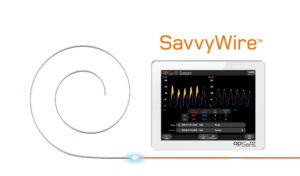 OpSens Medical has announced the successful completion of the first cases in a clinical study—SAFE-TAVI—studying SavvyWire left ventricular rapid pacing in transcatheter aortic valve implantation (TAVI) procedures in Europe.
OpSens Medical has announced the successful completion of the first cases in a clinical study—SAFE-TAVI—studying SavvyWire left ventricular rapid pacing in transcatheter aortic valve implantation (TAVI) procedures in Europe.
Ander Regueiro (Hospital Clínic de Barcelona, Barcelona, Spain) conducted the procedures as one of the primary investigators of the study. This study is part of the OpSens pre-CE mark clinical strategy that will lead to the commercialisation of SavvyWire in Europe.
OpSens’ SavvyWire has previously received Health Canada and US Food and Drug Administration (FDA) clearance. Using SavvyWire for left ventricular pacing can eliminate the need for venous access, reduce procedure time, and avoid potential complications associated with right ventricular pacing, the company says in a press release.
Josep Rodés-Cabau (Institut Universitaire de Cardiologie et de Pneumologie de Québec, Québec, Canada) is the global principal investigator of the SAFE-TAVI study that will enrol 120 patients with, among other conditions, severe aortic valve stenosis requiring a TAVI procedure in which left ventricular rapid pacing is considered necessary.
The SAFE-TAVI study is planned to be conducted at up to nine hospitals: in eight centres across Spain and Institut Universitaire de Cardiologie et de Pneumologie de Québec in Canada. As the global principal investigator of the SAFE-TAVI study, Rodés-Cabau will oversee and coordinate the principal investigators in their respective Spanish hospitals.
“I am extremely pleased with the performance of the SavvyWire,” said Regueiro. “We successfully used it on three cases today, implanting three different systems, including a Navitor TAVI system from Abbott, an Evolut system from Medtronic, and a SAPIEN 3 valve from Edwards Lifesciences. There is no doubt the SavvyWire allowed us to optimise our efficiency and workflow, while enhancing accuracy and patient safety.”
“The objective of the SAFE-TAVI study is to confirm the safety and efficacy of using left ventricular rapid pacing with the OpSens SavvyWire during TAVI procedures. Left ventricular rapid pacing is necessary to restrict the range of motion of the heart muscle during TAVI,” commented Rodés-Cabau.” This feature adds to the SavvyWire’s performance in enabling an efficient and effective workflow while providing real-time, accurate hemodynamic measurement in the TAVI procedure.”










